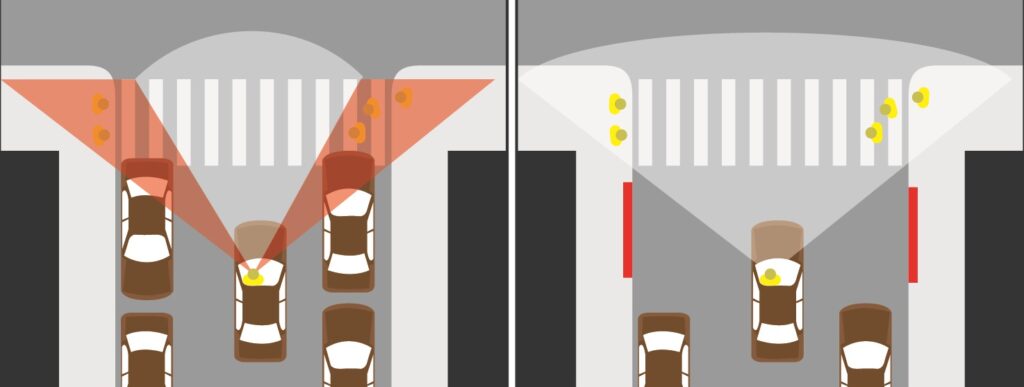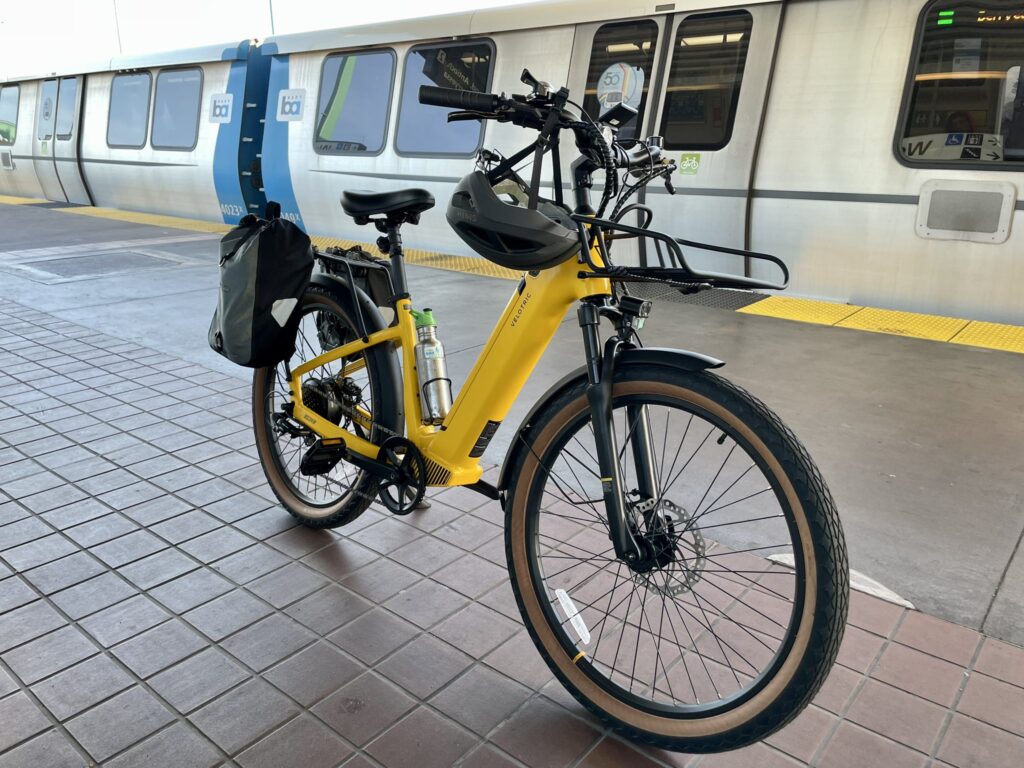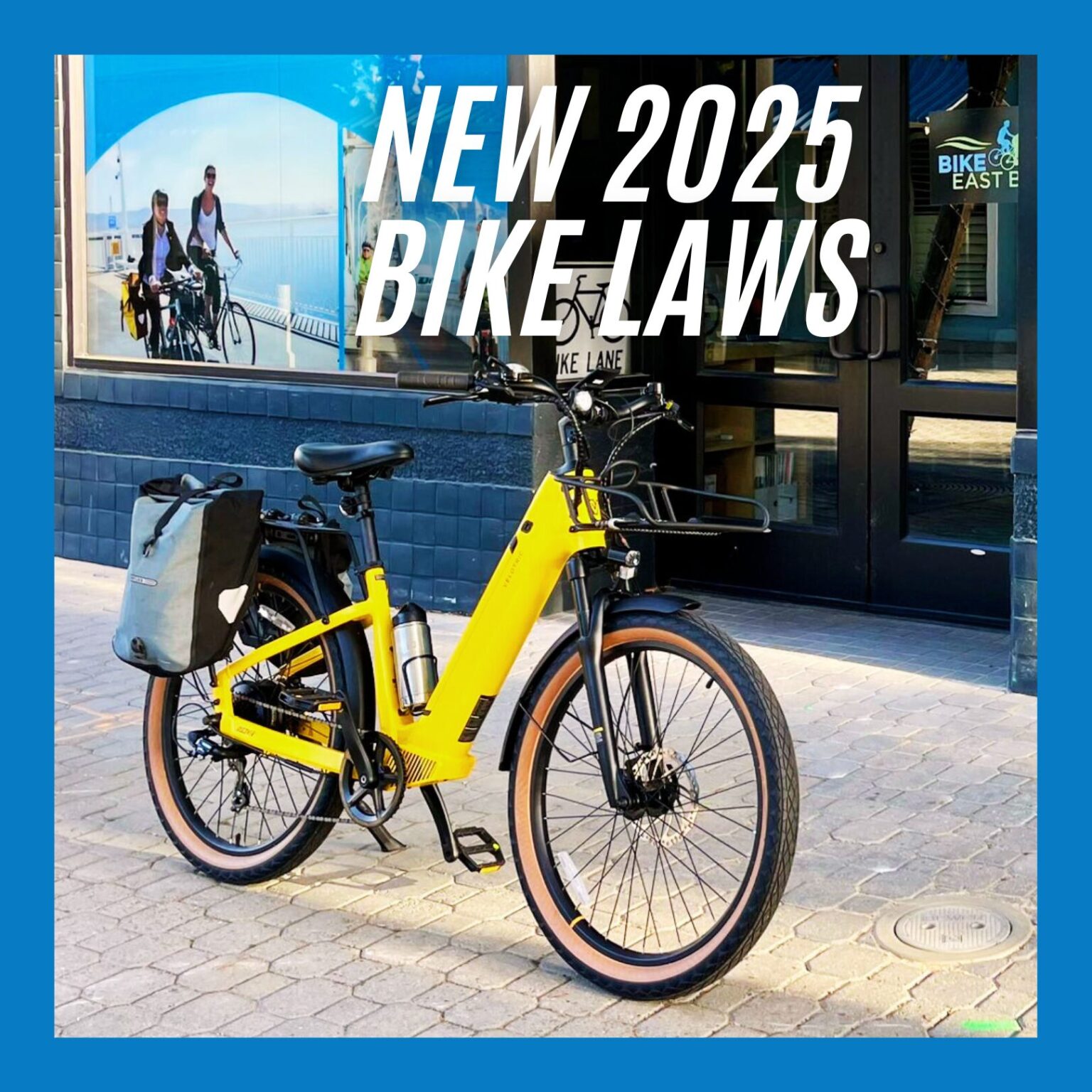Several new state laws took effect as of January 1st, 2025, regarding crosswalk safety, ebike regulation, shared lane bikeway markings, and drivers license job requirements.
Read on for complete details, and share this info with your friends to help spread awareness!
Parking Restrictions for Crosswalk Visibility

Last year we reported on this new law which went into effect in 2024, but was not enforceable until 2025.
Called the “Daylighting Saves Lives Bill” (text here), this rule restricts drivers from parking within 20 feet (about one car length) ahead of most street corners or mid-block crosswalks, or within 15 feet of a crosswalk where a curb extension into the roadway (aka a “bulbout”) is present. This applies even if the curb is not painted red.
Parking restrictions near corners and crosswalks is sometimes called “daylighting”, and these requirements have been in place in other states for many years.
Removing parking and other visual obstructions enables road users to see one another better at these crossing points, and has been shown to improve traffic safety.
Here is a helpful explainer video from the City of San Leandro:
Rule of thumb:
Some people have been asking how they can know if they are parking 20 feet away from a crosswalk.
Since 20 feet is approximately one parking space length, and most cars are between 14 to 18 feet long, a driver can start by pulling to the curb all the way at the front of the intersection.
If they can then reverse an entire car length plus a few feet, then they are far enough away from the corner. If there is not enough space to reverse a full car length plus a few feet, then it’s not a legal parking spot.
Although not a requirement, we encourage cities to mark these “no parking” areas via red paint to remove some of the guesswork for drivers, and to install on-street bike parking corrals or other physical features at corners to further prevent drivers from parking there.
Shared Lane Markings Prohibited on High Speed Roadways

As of 2025, Senate Bill 1216 (text here) now prohibits the use of new bicycle shared lane markings (aka “sharrows”) on any street with a posted speed limit above 30 miles per hour, except when used as an intersection crossing marking.
This rule applies whether or not the sharrow has a green backing (as shown above).
Removal of existing sharrows on streets above 30mph is not immediately required, though we encourage cities to update their streets with every available opportunity.
Previously, some jurisdictions were using these markings inappropriately on high speed roadways instead of providing separate painted or protected bikeways.
The use of sharrows is still permitted on lower speed streets, such as traffic-calmed neighborhood bike routes and bike boulevards.
Note:
There is also a pre-existing prohibition against using funding from the Transportation Development Act Article 3 (TDA3) program for any bike/car shared lane facilities (aka “Class 3 bikeways”) on any street in the SF Bay Area with a posted speed limit above 25 mph.
New Rules for Electric Bicycles

Senate Bill 1271 (text here) introduces a number of new regulations for ebikes in California, including:
- Class 3 ebikes which have a top unassisted speed of 28 mph are now required to be pedal assist-only, with no throttle allowed. Many Class 3 ebikes have both pedal assist and a throttle.
It is possible to easily disengage the throttle on many models, to ensure your Class 3 ebike remains legal. If you have any questions please contact the manufacturer for assistance. - Ebikes designed for users to easily subvert the speed limit and/or pedal assist requirements will no longer be permitted. Devices which enable this can not be advertised by the manufacturer as an ebike.
- All ebikes will now be limited to 750 watt motors, or below. Previously some ebike models had motors which normally operated at or below 750 watts but peaked above that level, or allowed users to increase the wattage above 750. This will no longer be permitted.
- All ebikes must have functional pedals. Previously some devices without pedals were being marketed as ebikes, which will no longer be allowed. Removal of pedals from a device will mean that it is no longer legally an ebike.
- Several additional ebike and e-scooter battery certification requirements will kick in starting in 2026 and 2027.
Drivers Licenses in Job Postings
As of 2025, Senate Bill 1100 (text here) now prohibits employers from including a drivers license requirement with job postings, unless:
- Driving is a function of the job, and…
- Alternate transportation (biking, walking, public transit) for that function isn’t comparable in travel time or cost to the employer.
It is still up to the employer to decide what “comparable travel time and cost” means, and there has not been much public communication about this prohibition yet.
So if you see any job postings that are likely non-compliant, feel free to follow up and let the employer know.


